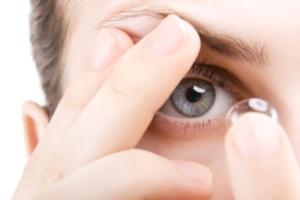The history of contacts and the improvements they hold for our future are fascinating subjects, since many of us have some form of vision problems.
Vision correction is a chronic need everywhere. Approximately 168.5 million residents in the U.S. use some form of corrective devices such as eyeglasses or contact lenses. That’s over half of the population in America!
More and more people are turning to contact lenses to bring their vision into focus. Since 1991, the number of contact lens wearers has increased by 4% per year. People’s reasons to wear contact lenses instead of glasses range from active lifestyle choices to cosmetic reasons.
What do contact lenses do?
Contact lenses are small prescription lenses, worn in “contact” with the eye. They are designed to correct refractive errors and maintain ocular health. They float on the tear film layer on the surface of the cornea.
Modern contacts are much more than small eye glass lenses that fit onto your eyes. They do, however, function much like regular eye glasses—refracting and focusing light so that objects appear clearly. Since the lenses stick to the tear fluid on your eye surface, they move naturally with you. This is but one advantage contacts have over glasses.
Types of contact lenses
Types of contacts are not all the same. They are available in different forms, designed to meet different purposes. These forms can range from their “modality,” or how often you change the contacts---say, daily, every two weeks, or monthly. They also fit different needs, such as contacts for astigmatism, contacts for nearsightedness, and more.
Contact lenses come in different strengths or “diopters.” If you wear contacts, take a look at their box or your prescription. You’ll see either plus or minus signs, followed by numbers. Without getting too in-depth, these convey the shape of the lenses. Different shapes correct different vision problems.
Toric lenses, which are more weighted at the bottom, help correct astigmatism. Spherical lenses, which are the same all around, help correct nearsightedness and farsightedness. There are also lenses for monovision, bifocals, and multifocals.
The history of technology—contact lenses
Contact lenses and their concept have been around for much longer than most people believe.
Along with many other modern day conveniences, Leonardo da Vinci envisioned the concept of contact lenses in 1508. In 1636, Renee Descartes took this further by sketching a protruding contact lens. Later, in 1801, a scientist named Thomas Young became the first to wear a contact lens, which was secured to his eye with wax!
Yes, we have come a long way in contact lens comfort.
Soft contact lenses
In 1971, the soft contact lens was officially introduced, ushering in a new era apart from the hard contact lenses of the past.
Daily contact lenses
The next major breakthrough in contact lens technology came in 1988 when the first disposable lenses were launched. It would then take eight years to introduce daily disposable contact lenses, or “dailies,” in 1996.
Silicone hydrogel contact lenses
Now we have silicone hydrogel lenses, which offer greater comfort and can be worn for longer periods of time in comparison to their predecessors.
Coloured contact lenses
Have you ever wished your eyes were slightly bluer than their natural hue? Now you can have just that—even if you don’t need your vision corrected.
There are cosmetic contact lenses to enhance, or even change, the colour of your eyes. This includes “plano,” or zero power, lenses with no magnification. (Read more about cosmetic contact lenses.) There are even black sclera contact lenses to complete your next Halloween costume. However, since contacts are medical devices, you should speak with an eye care professional before using such novelty contact lenses.
It seems like no matter what your vision needs may be, we now have contact lenses to fulfil them.
What’s next around the corner for contacts? Stay tuned!








